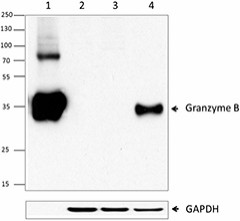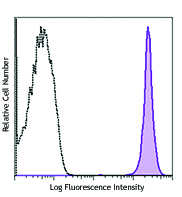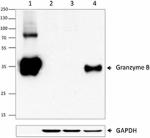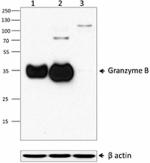- Clone
- O94E6/GZMB (See other available formats)
- Regulatory Status
- RUO
- Other Names
- Granzyme 2, cytotoxic T-lymphocyte-associated serine esterase 1, GZMB, CCP1, Asp-ase, CSPB, CTLA-1, CGL-1, CGL1
- Isotype
- Mouse IgG2a, κ
- Ave. Rating
- Submit a Review
- Product Citations
- 2 publications

| Cat # | Size | Price | Quantity Check Availability | Save | ||
|---|---|---|---|---|---|---|
| 674301 | 25 µg | 81€ | ||||
| 674302 | 100 µg | 240€ | ||||
Granzyme B is a serine protease that is produced mainly by cytotoxic T cells (CTL) and natural killer (NK) cells. It plays an important role in cytotoxic lymphocyte-mediated apoptosis, chronic inflammation, and impaired wound healing. Granzyme B is packaged in cytoplasmic granules that are exocytosed towards a bound target cell, which subsequently activates multiple protein substrates that induce apoptosis. Perforin facilitates the transfer of Granzyme B into the target cell. Most circulating CD56+, CD8-, NK cells, and approximately half of circulating CD8+ T cells coexpress both Granzyme A and B. The activation of CD8+ and CD4+ T lymphocytes induce substantial expression of Granzyme B, but not Granzyme A. Recently, Granzyme B has been found to be produced by other cell types such as CD34+ hematopoietic progenitor cells, keratinocytes, basophils, mast cells, plasmacytoid dendritic cells, B cells, and smooth muscle cells. Elevated levels of Granzyme B are also found in some kinds of autoimmune diseases, type 1 diabetes, and cardiovascular diseases.
Product DetailsProduct Details
- Verified Reactivity
- Human
- Antibody Type
- Monoclonal
- Host Species
- Mouse
- Immunogen
- Recombinant fragment corresponding to amino acids 21-247 of Human Granzyme B produced in E. coli.
- Formulation
- Phosphate-buffered solution, pH 7.2, containing 0.09% sodium azide.
- Preparation
- The antibody was purified by affinity chromatography.
- Concentration
- 0.5 mg/ml
- Storage & Handling
- Upon receipt, store undiluted at 4°C
- Application
-
WB - Quality tested
- Recommended Usage
-
Each lot of this antibody is quality control tested by Western blotting. For Western blotting, the suggested use of this reagent is 0.2 - 1.0 µg per ml. It is recommended that the reagent be titrated for optimal performance for each application.
- Product Citations
-
- RRID
-
AB_2564582 (BioLegend Cat. No. 674301)
AB_2564583 (BioLegend Cat. No. 674302)
Antigen Details
- Structure
- 247 amino acids with a molecular weight of approximately 28 kD.
- Distribution
-
Cytotoxic T cells, Natural killer (NK) cells, and neutrophils.
- Function
- Induces target cell apoptosis by activating caspase independent pathways and is induced in CD8+ T lymphocytes with ConA / IL-2 and CD4+ lymphocytes with anti CD3/CD28 or CD3/CD46.
- Interaction
- Targets of CTL and NK cells.
- Cell Type
- B cells, Dendritic cells, Neutrophils, NK cells, T cells
- Biology Area
- Apoptosis/Tumor Suppressors/Cell Death, Cell Biology, Cell Cycle/DNA Replication, Immunology, Innate Immunity, Neuroscience, Signal Transduction
- Molecular Family
- Enzymes and Regulators, Proteases
- Antigen References
-
1. Edwards KM, et al. 1999. J. Biol. Chem. 274:30468.
2. Grossman WJ, et al. 2004. Blood 104:2840.
3. Heusel JW, et al. 1994. Cell 76:977.
4. Schmid J and Weissmann C. 1987. J. Immunol. 1:250.
5. Trapani JA, et al. 1988. Proc. Natl. Acad. Sci. USA 85:6934.
6. Hiebert PR and Granville DJ. 2012. Trends Mol. Med. 12:732.
7. Saito Y, et al. 2011. J. Cardiol. 57:141.
8. Hiebert PR, et al. 2012. Trends Mol. Med. 18:732.
9. Ewen CL, et al. 2012. Cell Death Differ. 1:28. - Gene ID
- 3002 View all products for this Gene ID
- UniProt
- View information about Granzyme B on UniProt.org
Other Formats
View All Granzyme B Reagents Request Custom Conjugation| Description | Clone | Applications |
|---|---|---|
| Purified anti-Granzyme B | O94E6/GZMB | WB |
Customers Also Purchased




Compare Data Across All Formats
This data display is provided for general comparisons between formats.
Your actual data may vary due to variations in samples, target cells, instruments and their settings, staining conditions, and other factors.
If you need assistance with selecting the best format contact our expert technical support team.

 Login / Register
Login / Register 











Follow Us